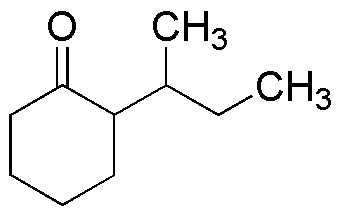2-sec-Butylcyclohexanone is widely utilized in research focused on:
- Solvent Applications: This compound serves as an effective solvent in various chemical reactions, particularly in organic synthesis, enhancing the solubility of reactants and improving reaction yields.
- Fragrance Industry: It is used in the formulation of fragrances and perfumes, providing a unique scent profile that is appealing in cosmetic products.
- Flavoring Agent: In the food industry, it acts as a flavoring agent, contributing to the taste of certain food products, making them more palatable.
- Intermediate in Synthesis: This chemical is a valuable intermediate in the production of other chemical compounds, enabling the development of pharmaceuticals and agrochemicals.
- Research and Development: It is often employed in laboratories for various research applications, including studies on reaction mechanisms and the development of new synthetic pathways.
General Information
Properties
Safety and Regulations
Applications
2-sec-Butylcyclohexanone is widely utilized in research focused on:
- Solvent Applications: This compound serves as an effective solvent in various chemical reactions, particularly in organic synthesis, enhancing the solubility of reactants and improving reaction yields.
- Fragrance Industry: It is used in the formulation of fragrances and perfumes, providing a unique scent profile that is appealing in cosmetic products.
- Flavoring Agent: In the food industry, it acts as a flavoring agent, contributing to the taste of certain food products, making them more palatable.
- Intermediate in Synthesis: This chemical is a valuable intermediate in the production of other chemical compounds, enabling the development of pharmaceuticals and agrochemicals.
- Research and Development: It is often employed in laboratories for various research applications, including studies on reaction mechanisms and the development of new synthetic pathways.
Documents
Safety Data Sheets (SDS)
The SDS provides comprehensive safety information on handling, storage, and disposal of the product.
Product Specification (PS)
The PS provides a comprehensive breakdown of the product’s properties, including chemical composition, physical state, purity, and storage requirements. It also details acceptable quality ranges and the product's intended applications.
Certificates of Analysis (COA)
Search for Certificates of Analysis (COA) by entering the products Lot Number. Lot and Batch Numbers can be found on a product’s label following the words ‘Lot’ or ‘Batch’.
*Catalog Number
*Lot Number
Certificates Of Origin (COO)
This COO confirms the country where the product was manufactured, and also details the materials and components used in it and whether it is derived from natural, synthetic, or other specific sources. This certificate may be required for customs, trade, and regulatory compliance.
*Catalog Number
*Lot Number
Safety Data Sheets (SDS)
The SDS provides comprehensive safety information on handling, storage, and disposal of the product.
DownloadProduct Specification (PS)
The PS provides a comprehensive breakdown of the product’s properties, including chemical composition, physical state, purity, and storage requirements. It also details acceptable quality ranges and the product's intended applications.
DownloadCertificates of Analysis (COA)
Search for Certificates of Analysis (COA) by entering the products Lot Number. Lot and Batch Numbers can be found on a product’s label following the words ‘Lot’ or ‘Batch’.
*Catalog Number
*Lot Number
Certificates Of Origin (COO)
This COO confirms the country where the product was manufactured, and also details the materials and components used in it and whether it is derived from natural, synthetic, or other specific sources. This certificate may be required for customs, trade, and regulatory compliance.


